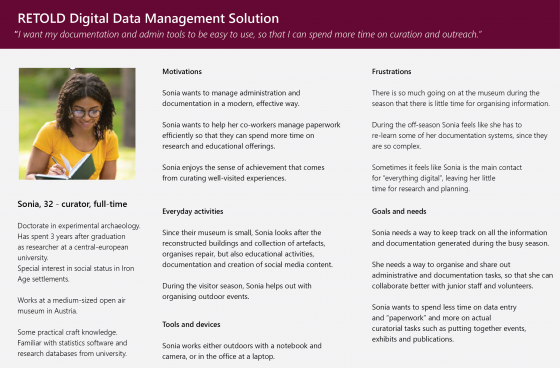
With already a year of exploratory research behind us, Nüwa have set themselves a deadline for our first in-person RETOLD meeting in June: We aim to construct a first design prototype for our proposed Digital Archiving and Documentation application, made specifically for use in Open-Air museums.
Through UX (User Experience) analysis and user interviews, we had already found out that most existing digital archiving solutions are more suited to “static” collection-based material, while open-air museums deal with the task of ongoing documentation of outdoor exhibits, often over several decades.
To ensure an ideation process that is focussed on the potential users of our design, we derived user personas from our interviews - the curator, the student volunteer, the craftsperson, and last (but perhaps not least) the museum director.
These personas serve as guidelines for the design process, to ensure that in our decisions and selection of features we focus on what our users are trying to achieve in their work.
Together with a visualisation of mental models, the personas also provided a starting point for further conversation with our museum partners, helping us verify if we were in fact addressing the most important issues faced in open air museums.
There were some common issues that we will keep in mind when proceeding with the prototype:
- The onus of conceptualising, organising, project managing and carrying out of documentation and archiving lay overwhelmingly with the curator.
- An overwhelming amount of knowledge in museums as organisations, and regarding documentation is implicit, to the point where sometimes questions might only be answered by personally visiting the knowledgeable person at their house.
- Organisation of archival material ranged from being carried out by dedicated employees, professional volunteers, or on a casual/occasional basis by museum employees.
- The variety of archival and documentary material was even more pronounced than anticipated, as was the variety of media utilised by museums, ranging from hardcopy, historical material, digital files, digitised hardcopy, physical objects, personal memorabilia, with an equally wide range of storage solutions.
- Museums work “in-person and hardcopy” first: Digitisation is currently a secondary step in documentation processes, occurring after data has been captured manually.
Before sketching out the screens of our prototype, we will first
- Map the activities and tasks that users need to accomplish using the digital product,
- Collate a list of content and media that the product needs to contain,
- Create an information architecture as the underlying structure for the product.
This process allows us to frequently gather feedback from potential users, and to test if the structure and categories we will use in the product actually make sense in the context of open air museums before deciding on concrete features.
During our meeting in Barcelona in June, we will be able to put the first version of our prototype through a round of usability testing - allowing us to iterate and further improve our design.
